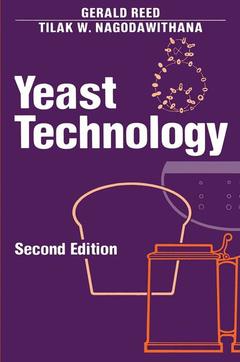Description
Yeast technology, 1991
Coordinator: Reed Gerald
Language: English
Publication date: 04-2012
454 p. · 15.2x22.9 cm · Paperback
454 p. · 15.2x22.9 cm · Paperback
Description
/li>Contents
/li>
Yeasts are the active agents responsible for three of our most important foods - bread, wine, and beer - and for the almost universally used mind/ personality-altering drug, ethanol. Anthropologists have suggested that it was the production of ethanol that motivated primitive people to settle down and become farmers. The Earth is thought to be about 4. 5 billion years old. Fossil microorganisms have been found in Earth rock 3. 3 to 3. 5 billion years old. Microbes have been on Earth for that length of time carrying out their principal task of recycling organic matter as they still do today. Yeasts have most likely been on Earth for at least 2 billion years before humans arrived, and they playa key role in the conversion of sugars to alcohol and carbon dioxide. Early humans had no concept of either microorganisms or fermentation, yet the earliest historical records indicate that by 6000 B. C. they knew how to make bread, beer, and wine. Earliest humans were foragers who col lected and ate leaves, tubers, fruits, berries, nuts, and cereal seeds most of the day much as apes do today in the wild. Crushed fruits readily undergo natural fermentation by indigenous yeasts, and moist seeds germinate and develop amylases that produce fermentable sugars. Honey, the first con centrated sweet known to humans, also spontaneously ferments to alcohol if it is by chance diluted with rainwater. Thus, yeasts and other microbes have had a long history of 2 to 3.
Preservation.- Nutrition.- 1 General Classification of Yeast.- Classification.- Impact of Recent Taxonomic Revision on Industry.- Yeasts of Economic Importance.- Culture Collection.- 2 Yeast Genetics.- Life Cycle.- Techniques Applicable to Yeast Strain Development.- Baker’s Yeast.- Brewer’s Yeast.- 3 Brewer’s Yeast.- General Characteristics of Yeast.- Yeast Characteristics Important for Brewing.- Brewing Process.- Brewery Contaminants.- Biochemistry of Brewing.- Recent Developments.- 4 Wine Yeasts.- Ecology.- Terminology.- Natural Yeasts and Their Occurrence on Grapes and in Musts.- Natural Fermentations.- Description of Species.- Selected Pure Culture Yeasts and Active Dry Wine Yeasts.- Preparation of Starter Cultures.- Biochemistry of Wine Fermentation165.- The Killer Factor184.- By-products of the Alcoholic Fermentation and Aroma Compounds.- Microbiological Reduction of Acids193.- Genetic Manipulation of Wine Yeasts198.- Microbial Spoilage of Wines199.- B?otrytis cineria 201.- Biogenic Amines and Ethyl Carbamate202.- Technology of Wine Making204.- Further Readings.- 5 Distiller’s Yeasts.- Whisky227.- Distillates from Sugar-Containing Raw Materials238.- Characteristics and Strains of Distiller’s Yeasts242.- Flavor Compounds248.- Fermentation Alcohol as Fuel252.- Further Readings.- 6 Baker’s Yeast Production.- Manufacturing Process Outline262.- Strains263.- Principles of Aerobic Growth264.- Raw Materials271.- Environmental Parameters280.- Practice of Aerobic Growth284.- Further Readings.- 7 Use of Yeast in Baking.- Function of Yeast in Baking316.- Bread Flavor334.- White Pan Bread Technology336.- Active Dry Yeast.- Further Readings.- 8 Yeast-Derived Products.- Flavor Products and Flavor Enhancers370.- Nutritional Yeast385.- Colorants Derived from Yeast390.- Yeast-Derived Enzymes393.- Products of Pharmaceutical and Cosmetic Value,.- 9 Food and Feed Yeast.- Composition415.- Use of Yeast as a Major Protein Source424.- Production of Biomass426.- Further Readings.- 10 Use of Yeasts in the Dairy Industry.- Cheese441.- Lactose-free Milk441.- Acidophilus-Yeast Milk442.- Kefir442.- Koumiss444.- Desugaring of Eggs.
© 2024 LAVOISIER S.A.S.




